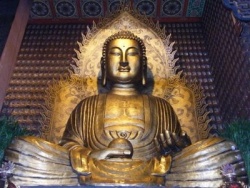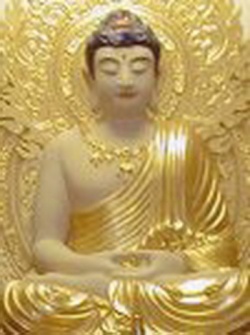Candrakirti's teaching on generosity and practice of generosity in modern Buddhist societies
Practice of generosity is an important aspect of the Buddhist religion. Buddhists distinguish three types of generosity: giving material offering, saving begins from fear and death, and giving Dharma teaching. It is believed that providing others with their needs and desires one accumulates merits and creates positive karma. This karma has potentiality to ripen in future life as positive circumstances for being endowed with wealth, health and comfort. Buddhists also believe that generosity brings ordinary beings on the path of liberation and becomes indispensable for those who desire enlightenment. Even thought Buddhists engage in generosity, the manner of their practice and focus might be different. Due to influential factors such as variety of cultural and social backgrounds one might find some differences in Buddhist perspective, motivation and conduct. As an example let’s address the manner how generosity is practiced and perceived by Tibetan and Western Buddhists.
The practice of generosity is widespread in the Tibetan society. Tibetans perceive generosity as part of their Dharma practice, believing that being generous would help accumulate merits. Most Tibetans practice generosity in various ways such as giving material offerings to those in need, saving animals from the slaughter and supporting the Dharma. For centuries religious sects and their monastic facilities were fully dependent on support of lay people. Being dependant on their donations religious leaders actively propagated the importance of generosity particularly for the needs of Dharma. Consequently, Tibetans consider generosity towards spiritual leaders, for sake of building monasteries and objects of worship, sponsoring prints of religious books and supporting monks to be generosity that brings most merits. Masters, on their side, generously offer Dharma teachings for benefit of their followers, provide community with opportunity of religious education, and often financially assist those in need.
The idea of generosity is not new to the Western society. Both [[Wikipedia:Christianity|Christianity]] and Judaism had been presenting charity as an important virtuous activity in a manner similar to Buddhism in Tibet. Both religions promoted importance of donation of material or monetary offerings for supporting religious facilities, orphanages, schools, hospitals and to the poor. The secular culture promoted charity in terms of support of development of sciences and art. Upon introduction of Buddhism to the West, practitioners accepted the ideas of generosity as they were presented in the Buddhist doctrine in adaptation to Western way of thought. Therefore, I would say that among Buddhists on the West generosity is practiced in two manners: in the traditional way according to the Tibetan scheme; as well as in a Western manner, according to the modern perception of social needs and benefit. Example of the “Tibetan scheme” of generosity could be any of Buddhist communities which depend on donations of their members. Members bring money, work power and more members, while community provides Dharma teachings, access to masters, place for practice and socialization. Following Tibetan example, many Westerners will be donating for building centers, stupas, statues and so on, as Tibetans considering donation for religious purposes to be highly meritorious.
Other Western Buddhists make a different consideration as to where to apply their practice of generosity. Their view is influenced by believing that immediate relief of someone’s suffering has a higher value over potential benefit from accumulated merits in future life. They often choose to help people, rather then invest money into religious objects. Generosity of such Buddhists often does not only focus on benefiting within the community but might spread also to non-Buddhists in need. Thus some Buddhist organizations volunteer in the hospices, or help after natural disasters wherever help is required.
Madhyamaka 7th century philosopher Candrakirti presents Bodhisattva as an ideal of generosity. He presents Bodhisattva as a realized one who is able to perceive the suffering of beings in all realms, and who takes enormous joy in helping them. While focusing on assisting others, he would completely disregard his own or suffering. This is ideal of practice of generosity – when one who is generous has no personal interest what so ever, not of gaining merit, nor of better future life for him. He would assist without limits of egoistic limitations of what to give and what to keep. The key point of such practice is the state of non-conceptual wisdom. At this moment when it is achieved, generosity can be practiced without any reference. Such generosity refers to higher spiritual development of Bodhisattvas when one does not perceive the duality between giver, receiver and act of giving. Until such accomplishment Buddhist may desire for positive circumstances, easy live, money and aspire for the Buddhahood.
Without doubt, this ideal presented by Candrakirti inspires many practitioners. It joins with Jatakas tales, in which is told story of Bodhisattva who offered his own body for benefit of a lioness as an example of capacity to limitless generosity. Majority of practitioners would see this capacity to be a future goal to aspire to achieve. Unfortunately in some cases few Buddhists had been confused, and tried to practice such limitless generosity while not having the capacity for it. In mild examples, practitioners had been offering their blood to mosquitoes and leaches, thinking that harming their own body they practice generosity. In more acute cases, both in Tibet and on the West, mentally unstable people harmed themselves in a more acute manner.
To summarize, the traditional manner of practicing generosity as seen in Tibet, affects the way it is taught and consequently practiced on the West. Nevertheless, specific cultural background and humane perception of the Westerners influences also their view on and application of practice of generosity. Though philosophical ideals of generosity are serving as inspiration to numerous Dharma practitioners both on the East and on the West, they are hard to achieve, being the peak of the Bodhisattva’s spiritual path.

